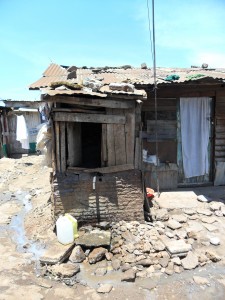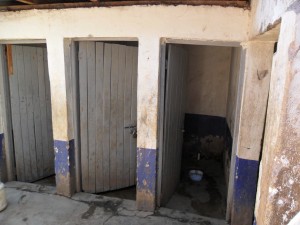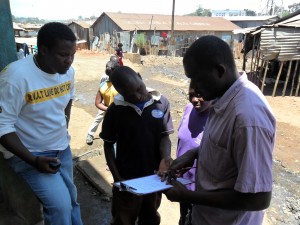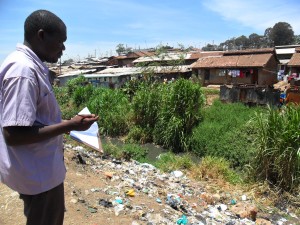Thematic mapping in Mathare kicked off yesterday! The past three weeks since the Mathare community forum the team has been concentrating on video training and new media work with the Mathare participants. We’ve had some really exciting discussions about how we can support the spin-off blogging project and integrate with SMS reporting in Mathare. We have also been working to develop data collection forms so that the mappers could begin collecting water and sanitation information.
We separated the data collection forms into three types of objects 1) toilets 2) water points 3) open defecation areas (or athara as they are known in Mathare). We printed out 10 copies of each data collection form with the hope of field testing them with the mappers. We wanted to know “do they make sense?†“What questions and/or responses are we missing?â€
Questions for the data collection forms were drawn from the Map Kibera team’s experience mapping water and sanitation points of interest and from Community Cleaning Services and Plan Kenya’s work on urban community total led sanitation in Mathare (view the draft data collection forms here).
A team of 11 Mathare mappers gathered at Community Transformer. We went over each question on each form. In terms of mapping toilets, there was debate about the various types of toilets. “Pit latrine†was straight forward, as well as “hanging toilet†(a toilet that sits over a river or drain and drops directly into the water below – we’ve also been told that in some parts of Asia this is referred to as a helicopter toilet). Other types of toilets “Asian†and “European†and “Trench†weren’t immediately clear to the mappers.
The team broke into 3 separate groups to test out the forms. The main feedback on the forms included breaking the types of government run toilets into those run by the CDF vs LATF. This will be important for different groups that undertake social auditing. The other observation is that water in Mathare is usually purchased by the 20L gallon, so we changed the data collection form to that effect.
Measuring the number of people of use a toilet per day is difficult. For toilets that sit by the river and do not have a caretaker, this is nearly impossible (without sitting and counting people entering the toilet). Collecting information about toilets that belong to institutions (schools and churches) is quite time consuming. Entering the premises requires a formal introduction to the secretary or other person-in-charge. The school and church we visited were very welcoming and gave us quite a bit of information. We were able to find out that there are about 800 staff and students using just 6 toilets and 1 urinal at the school. The church next door had 5 toilets that were very well maintained. The church has about 100 visitors on week days and 500-1000 on the weekend.
Open Defecation areas (or athara) are large areas where people come to shit outside. This is due to lack of access to toilets – for reasons such as ability to pay, proximity to the nearest toilet, security, etc. These areas are used in the early morning and evening due to the issue of privacy. It is very difficult to estimate the number of people who use an athara – the only good option would be to count the piles of shit (not feasible in this case, because the volunteer mappers don’t have the appropriate footwear nor expertise in sanitation issues). More on mapping open defecation areas….
Every organization or a CBO or an NGO is looking for a different set of information when carrying out work on water and sanitation. The Map Mathare team is building a geographic database of different facilities with some basic attribute information. It’s our hope that sanitation specialists, public officials, youth groups, CBOs and others can and will utilize this information. At this point, we are in the process of field testing data collection tools to determine the baseline the mappers will build . In this case, the accuracy of information the mappers collect will decrease with the number of questions on the data collection tool, so we are looking for the balance between accuracy and level of detail. The mappers and the coordination team are learning a lot! By the end of March we hope to have a team of 10-20 dedicated, certified mappers!




